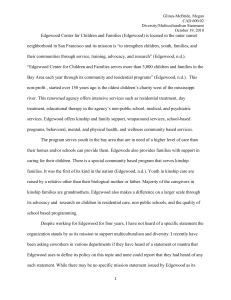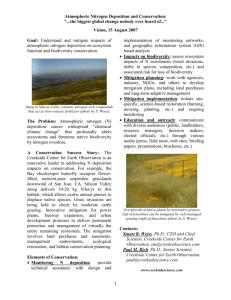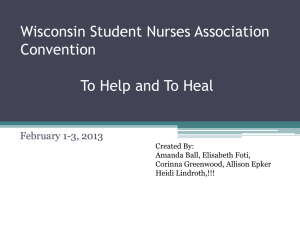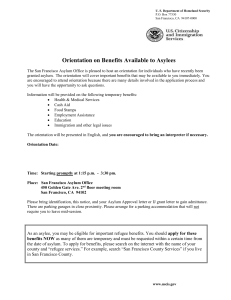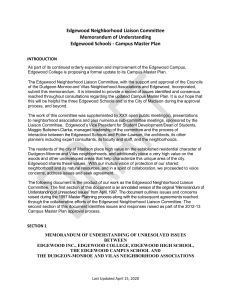cad 600 community and organizational assessment
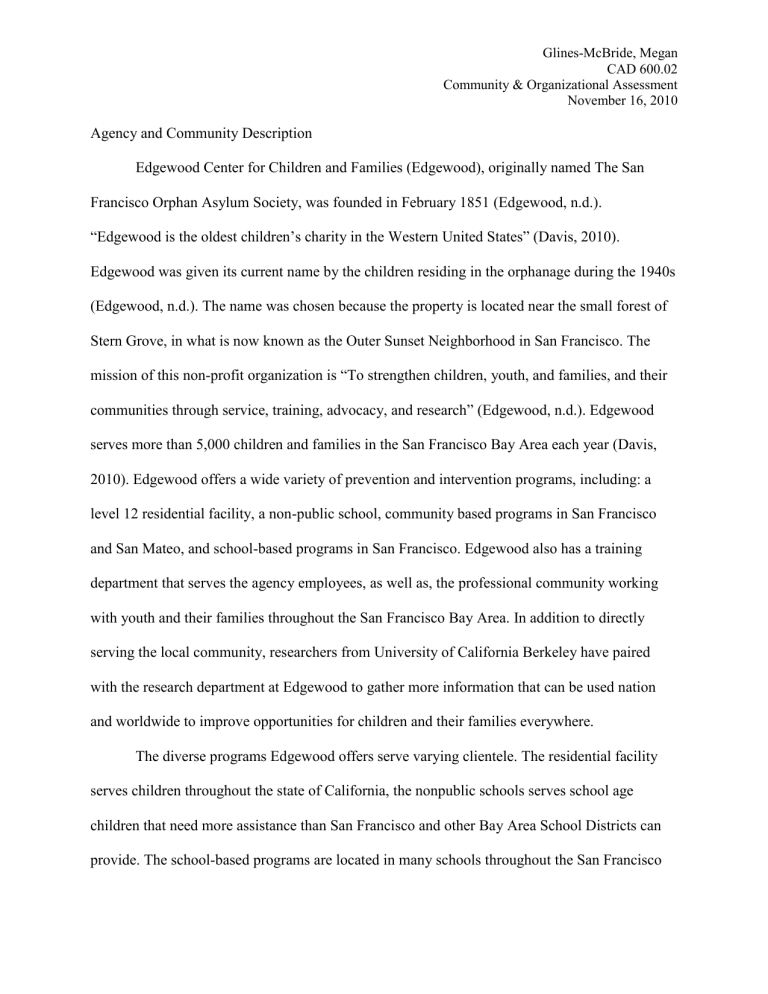
Glines-McBride, Megan
CAD 600.02
Community & Organizational Assessment
November 16, 2010
Agency and Community Description
Edgewood Center for Children and Families (Edgewood), originally named The San
Francisco Orphan Asylum Society, was founded in February 1851 (Edgewood, n.d.).
“Edgewood is the oldest children’s charity in the Western United States” (Davis, 2010).
Edgewood was given its current name by the children residing in the orphanage during the 1940s
(Edgewood, n.d.). The name was chosen because the property is located near the small forest of
Stern Grove, in what is now known as the Outer Sunset Neighborhood in San Francisco. The mission of this non-profit organization is “To strengthen children, youth, and families, and their communities through service, training, advocacy, and research” (Edgewood, n.d.). Edgewood serves more than 5,000 children and families in the San Francisco Bay Area each year (Davis,
2010). Edgewood offers a wide variety of prevention and intervention programs, including: a level 12 residential facility, a non-public school, community based programs in San Francisco and San Mateo, and school-based programs in San Francisco. Edgewood also has a training department that serves the agency employees, as well as, the professional community working with youth and their families throughout the San Francisco Bay Area. In addition to directly serving the local community, researchers from University of California Berkeley have paired with the research department at Edgewood to gather more information that can be used nation and worldwide to improve opportunities for children and their families everywhere.
The diverse programs Edgewood offers serve varying clientele. The residential facility serves children throughout the state of California, the nonpublic schools serves school age children that need more assistance than San Francisco and other Bay Area School Districts can provide. The school-based programs are located in many schools throughout the San Francisco
Glines-McBride, Megan
CAD 600.02
Community & Organizational Assessment
November 16, 2010
Unified School District and serve the children that attend them. The community based programs offer support to kinship families in both San Francisco and San Mateo Counties. The majority of the families enrolled in the kinship program in San Francisco live in Bayview/Hunter’s Point,
Western Addition, Mission, and Chinatown Neighborhoods. The kinship program in San
Francisco serves over 200 children living with family members other than their biological parents each year.
Edgewood’s main campus is located at Vicente Street and 30 th
Avenue in San Francisco.
Next to the campus is a park the size of a city block and single-family homes surround the rest of it. The site in San Carlos is located in a small industrial neighborhood. Neither of these locations are in, nor do they reflect, the neighborhood of the clients served by the agency. Edgewood also has three satellite locations held within these community buildings: Thrive House in the Western
Addition Neighborhood of San Francisco, the Bayview YMCA in the Bayview/Hunter’s Point
Neighborhood of San Francisco, and the Drop-In Center off of the main road in San Bruno. The
San Francisco satellite offices share space with other youth development and family support agencies. They are located in areas where the majority of the agency’s clients live; which are low-income neighborhoods with large amounts of Section 8 housing. These neighborhoods have grocery stores and small markets, post offices, and public transportation. They are also very dangerous due to high rates of gang violence and drug abuse. Similar to the neighborhoods they reside in, the majority of population Edgewood serves are suffering from high rates of poverty, mental health issues, and are part of a racial minority.
Agency Governance and Structure
Glines-McBride, Megan
CAD 600.02
Community & Organizational Assessment
November 16, 2010
Edgewood operates as a 501c3 Nonprofit Organization that offers a wide variety of programs and partners with local agencies with similar missions (e.g. Seneca Center, SFUSD) to reach as many children and their families as possible. The agency is governed by a Board of
Directors led by Chairman Paul B. Holm, Jr, and Vice Chairman Brooke Shields. The sixteen
Board members names are as follows: Donna Abrahamson, Suzanne Bird, John Bell, Luis A.
Belmonte, David H. Black, Elizabeth Strong Coover, Denise Dettore, Julie Flynn, Graeme
Hanson, M.D., Jeannie Harris, Julene Hunter, Cynthia Lohr, Jon. H. Paulsen, Miriam Rike,
Adrian Sawyer, and Paul R. Touchstone (Edgewood, n.d.). “The Board of Directors of
Edgewood holds the authority and responsibility for managing the corporation. Its role is to guard the mission of the agency and to maintain high standards of accountability. The Board is ultimately responsible for making sure that the corporation runs properly” (Edgewood, 2007).
New board members are chosen by the existing Board of Directors, although anyone within the agency can refer an individual to be a candidate. The members are expected to attend nine monthly meetings annually, the annual Board retreat in October, serve actively on at least one committee, and to make a minimum contribution of $10,000 to the agency each year (Edgewood,
2007). The Board does not reflect the population served by the agency and there are no staff members or clients on the Board.
The organization is run daily by the Chief Executive Officer (CEO). The CEO works closely with the Chief Financial Officer, the Medical Director, and the Chief of Programs and
Strategy to ensure that the agency is run effectively and efficiently. The CEO reports to the
Board of Directors. The Chief of Programs and Strategies works directly with the directors of the
Glines-McBride, Megan
CAD 600.02
Community & Organizational Assessment
November 16, 2010 various programs to make certain that the agency is meeting the needs of the clients it is working to serve. (For organizational chart of Edgewood’s Kinship Program see Appendix A)
Client and Community Involvement
The support group facilitators for the kinship programs are led by caregivers of kinship families that have been hired by Edgewood. They are able to provide a higher level of comfort and insight for the members of the support group, as they have shared an experience similar to what the members of the support group are facing. Within recent months Edgewood has started a
Community Advisory Council that provides a direct link from the clients to the CEO. There is also a Youth Advisory Board that provides this opportunity specifically for the youth in the kinship program. Both hold open forums for the clients to bring their insight into the successes and faults of the programs to the people in charge of their programs and the CEO.
Edgewood utilizes the expertise of the community through the 800 volunteers it receives each year (Davis, 2010). Edgewood’s training department also contracts with professionals in the
San Francisco Bay Area to provide a comprehensive array of training topics throughout the year.
The nonpublic school brings in a variety of talented community members for their assemblies and has sports teams that compete with other nonpublic schools.
Communication
Edgewood holds quarterly all-staff meetings led by the CEO to update employees on the agency’s status, policy and procedure updates, and future plans. The last all-staff meeting included information about cell phone policy updates and the fiscal status of the agency. For the past three years this is how the employees have learned that the agency will be having a weeklong furlough from Christmas to New Years. Each program also holds monthly meetings for
Glines-McBride, Megan
CAD 600.02
Community & Organizational Assessment
November 16, 2010 their staff to keep employees updated on information specific to that program. The meetings include updates on upcoming events for clients, changes to program policies and/or procedures, and progress made by clients within the program, as well as, the program as a whole. Most of the day-to-day communication among employees takes place through email. Depending on the structure and location of the program some employees of certain programs are able to speak face-to-face more than others. Emails are regularly used to inform employees of events at the agency (e.g. staff meetings, assemblies, and holiday parties).
Employees at Edgewood are not forced to speak with their immediate supervisor before taking issues to higher levels of management, although it is not encouraged. Each employee has regular supervision meetings with their supervisor; this time is meant to check in with the employees about their progress and drawbacks in fulfilling their duties. Edgewood works hard to make sure that every employee has an outlet they feel comfortable venting to. A current employee at Edgewood was having difficulty communicating with her supervisor and was able to change supervisors for her supervision meetings.
Edgewood uses its various programs to distribute information to its clients. Each program communicates differently with the families. The kinship program sends out monthly calendars and flyers to each of the families enrolled in the program. This is how the kinship families are notified of the agency-wide furlough this year. The nonpublic school sends home daily behavior reports with its students. Due to HIPAA constraints the programs are not able to utilize social networking sites (e.g. Facebook) to communicate with the families. On a day-day-to basis the families are reached via telephone by the agency’s employees. In rare cases, employees communicate with employees via email.
Glines-McBride, Megan
CAD 600.02
Community & Organizational Assessment
November 16, 2010
Organizational Funding
Edgewood currently operates off $26 million each year. 23 million dollars, or 88% of the money is from public funding and 3 million dollars, or 12% of the money is from private donations. The 3 million dollars in private donations Edgewood receives each year is due to the hard work of the development department. The private donations include the following types: planned giving, in-kind donations, events (e.g. Hope Ball, Edgewood Fair), individual giving, and institutional giving (Davis, n.d.).
Edgewood’s Board members, along with the CEO, are expected to play a major role in fundraising for the agency. The members collaborate with the development department to hold the agency’s main fundraising events. Employees and clients have played a major role in recent fights to ensure the agency still receives its funding from the state and county. They have been recruited by the agency to send letters to the local and state government officials, attend and speak at local council meetings, and rally at the state capitol. Edgewood utilizes its large numbers in both employees and clients to fight for the rights of the children and their families.
Summary
Through this assignment I learned more about the specific requirements for participating in the different programs at Edgewood. Each program has different eligibility criteria, there are no universal criteria for participating in all of the agencies programs, nor are participants expected to utilize all of the programs Edgewood has to offer. I was surprised to learn how many of the mental health programs, including residential treatment, require the youth to be on Medical. Edgewood is a large agency, as is evident by the number of programs offered and size of
Glines-McBride, Megan
CAD 600.02
Community & Organizational Assessment
November 16, 2010 population served. I learned that its operating budget is currently $26 million dollars annually, with the majority of expenditures going to direct service staff (Davis, 2010).
It is no surprise that such a large agency has a multimillion dollar operating budget, or that it was hit hard financially with the recent economic downfall in the United States of
America. As a result of this, Edgewood has taken annual furloughs for the last three years and has not been able to give its employees a cost of living allowanced for over five years. If I could change something at the agency it would have been first and foremost to better protect
Edgewood’s financial investments from economic instability and diversify funding sources as much as possible. I would also reevaluate the structure of the management of the agency, just as they have done with all of the programs, to cut redundant positions. Edgewood operates with multiple chief operators and it seems that the programs are being cut down to skeleton crews while the management, the highest paid positions, has taken very minor cutbacks.
I would also like to see Edgewood work to establish intentional collaborations between programs to provide its clients with wrap-around services. With the variety of programs run by
Edgewood, it seems to be the perfect opportunity to offer services that are coordinated to work together. If I could change anything it would be to establish a more standard set of eligibility requirements for the programs so that the clients could utilize as many programs as possible. The agency currently operates with the programs acting as isolated pods when in fact they could be used to provide a more holistic approach to working with children and their families.
In the past year I have watched Edgewood lose its CEO, Chief of Programs and Strategy, and a couple other top management positions. It has been interesting watching this process and I have been inspired by this change. I have already observed the new CEO actively working to
Glines-McBride, Megan
CAD 600.02
Community & Organizational Assessment
November 16, 2010 integrate himself into and get to know the agency’s programs and employees. He talks of making big changes throughout the agency and has already started evaluations on all of the programs.
The truth of this statement is evidenced by the fact that in his short time in charge he already had the cottages where the children live repainted and cleaned up.
I recently had the opportunity to observe a meeting of the Board of Directors. They held an open meeting in compliance with the Sunshine Ordinance. I observed that the vast majority of the board members were white, which is not reflective of the population served by the agency.
When researching the Board members I learned that they were all well educated and financially successful. This is also not representative of the agency’s clientele. I feel it is important for the agency to reflect the population it serves as much as possible.
Glines-McBride, Megan
CAD 600.02
Community & Organizational Assessment
November 16, 2010
References
Davis, Jeff. (2010, October 13) All-Staff Meeting . Edgewood Center for Children and Families.
Edgewood Center for Children and Families (2000). KSN Organizational Chart.
San Francisco,
CA.
Edgewood Center for Children and Families (2007). Candidate Questionnaire.
San Francisco,
CA.
Edgewood Center for Children and Families (n.d.). Board of Directors. Retrieved from http://www.edgewood.org/whoweare/about/board.html
Edgewood Center for Children and Families (n.d.). History.
Retrieved from http://www.edgewood.org/whoweare/about/history.html
